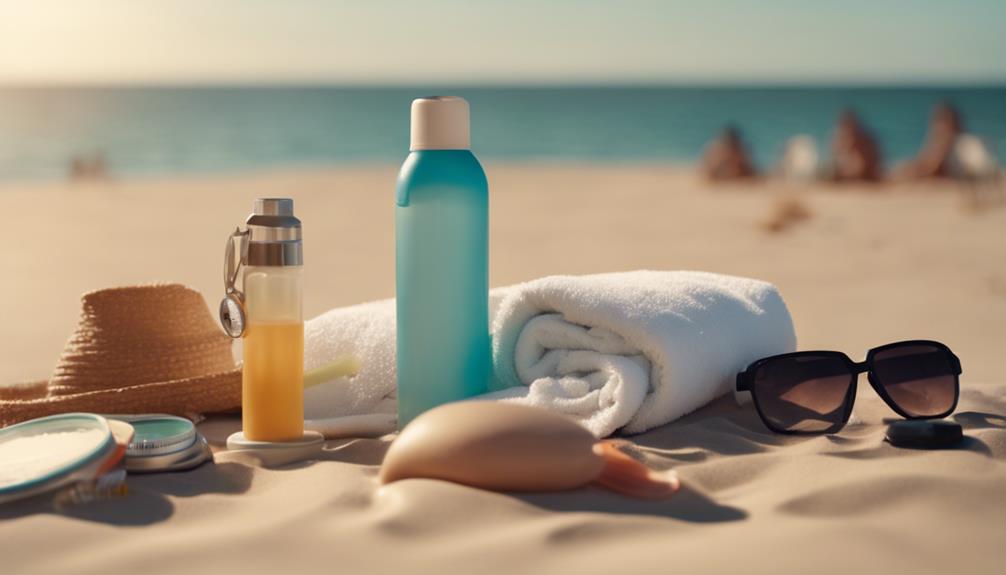For optimal tanning results, begin by determining your skin type. Those with fair skin should aim for 1-2 sessions per week, while individuals with darker skin can handle up to 5 sessions. Prior to tanning, make sure to exfoliate and hydrate your skin. Ease into your tanning sessions by starting with short durations and gradually increasing them as your skin becomes accustomed. It is essential to prioritize post-tanning care by moisturizing to maintain your tan. Be mindful of any signs of irritation and adjust your tanning schedule accordingly. By following these steps, you can achieve the best tanning outcomes. Learn how to effectively apply these strategies for a beautiful, long-lasting tan.
Key Takeaways
- Identify your skin type using the Fitzpatrick Scale to determine optimal tanning frequency and session duration.
- Exfoliate and hydrate your skin 24 hours before tanning to ensure an even and effective tan.
- Start with shorter sessions of 5-10 minutes and gradually increase as your skin adapts to UV exposure.
- Limit tanning to one session per day and reduce to two sessions weekly for maintenance to avoid overexposure.
Identifying Your Skin Type
To effectively tailor your tanning sessions, start by identifying your skin type using the Fitzpatrick Scale. This scale categorizes skin into six types based on how easily it burns or tans.
If you have fair skin that burns easily, you should begin with brief tanning sessions to build a base tan, ideally 1-2 times a week.
For medium skin types, aim for 2-3 sessions a week, while olive skin can handle 3-4.
Darker skin can tolerate 4-5 sessions weekly but still needs caution.
Gradually extend the duration of your tanning sessions as your skin adapts, and always adjust your frequency based on how your skin reacts to avoid overexposure and guarantee ideal results.
Preparing for Your Sessions

Before heading to your tanning session, make certain to exfoliate your skin 24 hours in advance to remove dead skin cells and promote an even tan. This step is essential for achieving the best results.
Next, hydrate your skin adequately; dry skin won't tan well. Use a good moisturizer daily leading up to your session.
It's also important to arrive with clean, makeup-free skin, as this guarantees a smooth application of tanning products. Avoid any products that might block UV rays, like sunscreen or lotions with oils.
Managing Tanning Sessions

Managing your tanning sessions effectively involves starting with shorter durations to prevent overexposure and gradually increasing the time as your skin adjusts.
Here are three key tips to help you manage your tanning sessions:
- Start Slow: Begin with 3-5 sessions of 5-10 minutes each, especially if you have lighter skin.
- Incremental Increase: Once your skin adapts, extend your sessions by 2-5 minutes, monitoring for any signs of irritation.
- Limit Frequency: Stick to one session per day and reduce to 2 sessions weekly for maintenance after achieving your desired tan.
Post-Tanning Care

Applying moisturizer immediately after tanning helps prevent peeling and keeps your skin hydrated. Choose a high-quality moisturizer or a professional tan extender to enhance your tan's longevity. These products work by locking in moisture, allowing your skin to maintain its glow while preventing dryness. Remember to apply the moisturizer gently, avoiding harsh scrubbing.
In addition to moisturizing, drink plenty of water to keep your skin hydrated from the inside out. Monitor your skin's condition, and adjust your tanning schedule as necessary. If you notice any irritation or dryness, consider reducing the frequency of your tanning sessions.
Prioritizing post-tanning care not only preserves your tan but also promotes healthier skin overall. Enjoy your radiant results!
Safety and Health Guidelines

To enjoy your tan safely, it's important to follow specific health guidelines that protect your skin while maximizing your results.
Here are three key practices you should adopt:
- Know Your Limits: Understand your skin type and avoid excessive UV exposure. Start with shorter sessions and gradually increase the time as your skin adapts.
- Stay Hydrated: Keep your skin moisturized before and after tanning. Hydrated skin tans more evenly and reduces the risk of peeling.
- Rotate Positions: Change your position during tanning sessions to guarantee an even tan and prevent overexposure in specific areas.
Frequently Asked Questions
Can I Tan if I Have Sensitive Skin?
Yes, you can tan with sensitive skin, but start slow. Use shorter sessions and monitor your skin's reaction. Exfoliate, hydrate, and always prioritize sun protection to prevent irritation and achieve a beautiful, even tan.
What Should I Wear During Tanning Sessions?
Think of yourself as a canvas; wear minimal clothing—like a swimsuit—to expose skin evenly. Avoid tight straps or dark colors that can cause tan lines, and consider protective eyewear to shield your eyes from UV rays.
How Do I Know When to Stop Tanning?
You'll know to stop tanning when your skin shows signs of redness or irritation. Monitor your skin's reaction, and if you experience discomfort, take a break. Balance is key for maintaining a healthy, beautiful tan.
Are There Any Products to Enhance Tanning Results?
Yes, there are products like tanning oils, lotions, and bronzers that enhance results. Look for those with moisturizing ingredients and natural bronzers to amplify your tan and keep your skin hydrated and glowing.
Can I Tan While Taking Medication?
Imagine your skin as a delicate flower, needing care. While some medications can affect tanning, it's wise to consult your doctor first. They can guide you through potential side effects and safe tanning practices.
What Role Does Smart Scheduling Play in Achieving the Best Tan?
Smart scheduling is crucial in achieving the best tan for your skin color. By carefully planning your tanning sessions, you can avoid overexposure and ensure an even, natural-looking glow. Understanding your skin type and the optimal tanning times for your complexion is key to achieving the best results. If you have fair or sensitive skin, it’s important to start with shorter tanning sessions and gradually increase the time as your skin builds up a tolerance to UV exposure. Additionally, using the right SPF sunscreen for your skin type will help protect against sunburn and damage. Following these perfect tanning tips will help you achieve a beautiful and safe tan that enhances your natural complexion.
Conclusion
By understanding your skin type and following a smart scheduling plan, you can transform your tanning experience from a gamble into a well-orchestrated symphony. Understanding your skin type is essential for developing a tanning regimen that will help you achieve a golden glow without damaging your skin. Creating a smart scheduling plan involves knowing how often and for how long you can safely tan, based on your skin’s sensitivity and natural pigmentation. By following these principles, you can unlock the secrets of perfect tanning and achieve a radiant, healthy glow without risking burns or long-term damage to your skin. Unlocking the secrets of tanning also involves using the right products, such as a high-quality sunscreen and a moisturizing lotion. In addition to following a smart scheduling plan, it’s important to stay well-hydrated and to listen to your skin’s signals. By incorporating these elements into your tanning routine, you can ensure that your skin stays healthy and vibrant while achieving a beautiful tan. The secrets of tanning lie in the careful balance of timing, products, and self-care, leading to a glowing complexion that will turn heads.
Picture yourself basking in the sun's warm embrace, confidently flaunting a radiant glow that enhances your natural beauty.
With the right preparation, careful management, and diligent aftercare, you'll not only achieve that coveted tan but also protect your skin's health.
Embrace this journey, and let your glow shine brightly!









